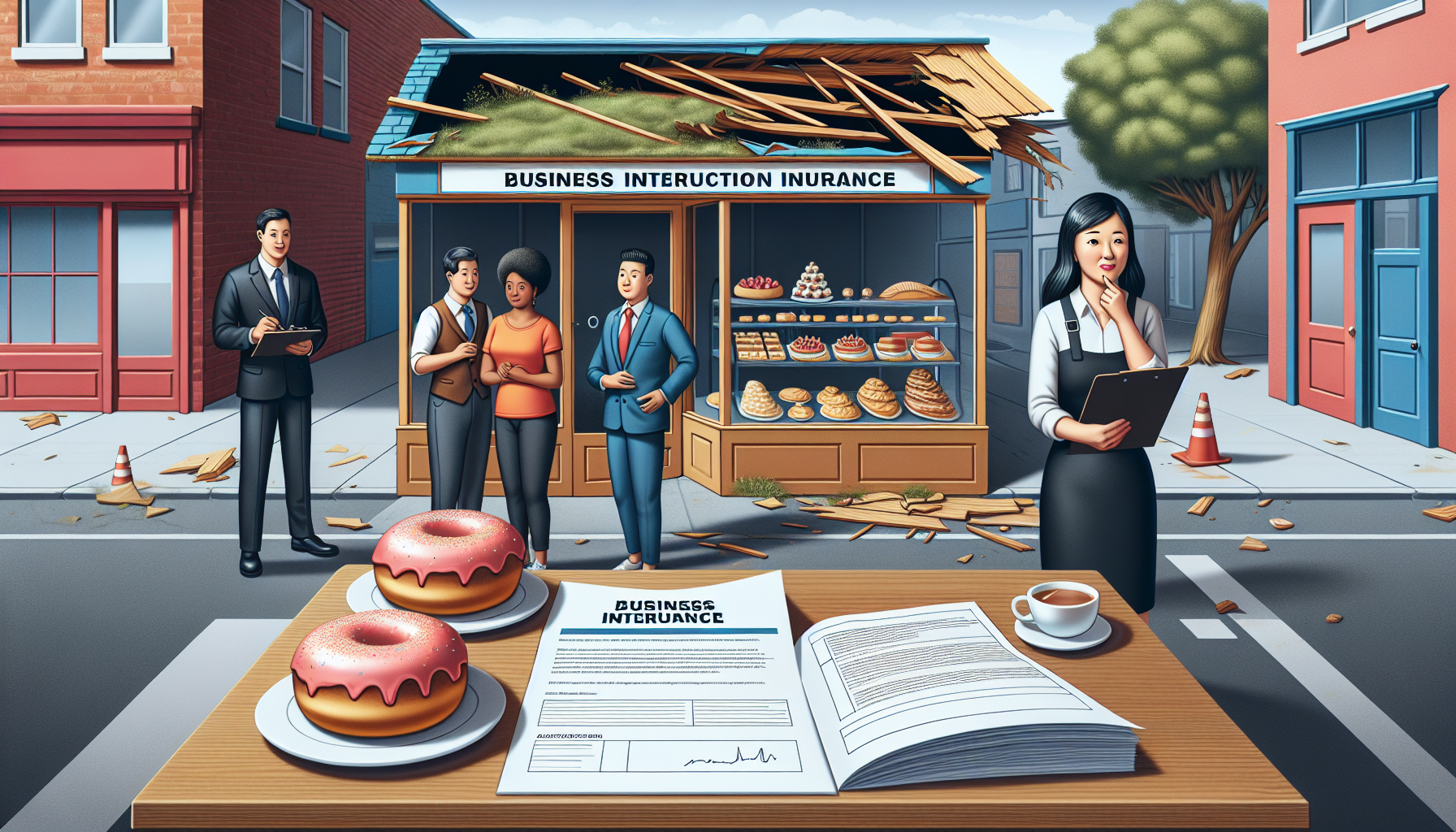What Is Business Interruption Insurance in 2025?
Business interruption insurance has become more critical than ever in 2025, as companies face an unprecedented range of threats that can halt operations overnight. From cyber attacks and supply chain disruptions to natural disasters and pandemic-related shutdowns, modern businesses need comprehensive protection against revenue loss.
This essential coverage acts as a financial lifeline when your business cannot operate normally due to covered events. Unlike standard commercial property insurance that covers physical damage to buildings and equipment, business interruption insurance specifically protects your income stream and helps cover ongoing expenses during forced closures.
In this comprehensive guide, we’ll explore everything you need to know about business interruption insurance in 2025, including how it works, what it covers, recent changes in the industry, and how to determine if your business needs this protection.
Understanding Business Interruption Insurance: The Basics

Business interruption insurance, also known as business income insurance or loss of income insurance, provides financial protection when your business operations are temporarily suspended due to covered perils. This coverage is designed to help maintain your financial stability during periods when you cannot generate normal revenue.
The fundamental principle behind business interruption coverage is simple: it replaces lost income and covers necessary expenses when your business cannot operate due to circumstances beyond your control. This includes situations where your physical premises are damaged, your supply chain is disrupted, or government authorities mandate closures.
How Business Interruption Insurance Works
When a covered event occurs that forces your business to suspend operations, business interruption insurance kicks in to provide financial support. The coverage typically begins after a waiting period (usually 72 hours) and continues until your business can resume normal operations or until the policy limits are reached.
The insurance company calculates your lost income based on your historical financial records, typically using the previous 12 months of business performance as a baseline. This calculation considers your gross earnings, including net income and necessary continuing expenses that would have been earned during the interruption period.
Most policies also include coverage for extra expenses – additional costs you incur to minimize the interruption or to operate temporarily from an alternative location. These might include rental fees for temporary facilities, overtime wages, or expedited shipping costs for essential supplies.
What Does Business Interruption Insurance Cover in 2025?
The scope of business interruption coverage has evolved significantly in recent years. Here’s what modern policies typically include:
Core Coverage Areas
Lost Revenue Protection: The primary function of business interruption insurance is replacing lost income during the suspension period. This includes profits you would have earned and fixed expenses that continue even when operations are halted, such as rent, loan payments, and employee salaries.
Continuing Operating Expenses: Your business likely has fixed costs that don’t stop just because operations do. Business interruption insurance helps cover these ongoing expenses, including rent or mortgage payments, utilities, insurance premiums, and loan obligations.
Payroll Protection: Many policies include coverage for employee wages and benefits during the interruption period. This helps businesses retain valuable staff members and maintain team cohesion during challenging times.
Extra Expenses Coverage: When disasters strike, businesses often incur additional costs to minimize the interruption or maintain operations. This might include renting temporary space, purchasing or leasing replacement equipment, or paying premium rates for expedited services.
Extended Coverage Options
Contingent Business Interruption: This coverage protects against losses when key suppliers, customers, or business partners experience interruptions that affect your operations. For example, if your primary supplier’s facility is damaged by fire, preventing them from delivering essential materials to your business.
Civil Authority Coverage: When government agencies order evacuations or restrict access to your business area due to nearby incidents, civil authority coverage provides protection for resulting income losses.
Ingress and Egress Coverage: This protects against losses when customers or employees cannot reach your business due to blocked access routes, even if your property remains undamaged.
Utility Interruption Coverage: Power outages, water service disruptions, or telecommunications failures can severely impact business operations. This coverage protects against losses from utility service interruptions originating off your premises.
Industry-Specific Considerations
Different industries face unique risks and may require specialized business interruption coverage:
Manufacturing Businesses: These operations often need extended coverage for machinery breakdown, supply chain disruptions, and extended production restart periods.
Retail Operations: Seasonal businesses and retailers may require coverage that accounts for peak selling periods and inventory concerns.
Healthcare Facilities: Medical practices and healthcare facilities need coverage that considers patient care continuity and regulatory compliance requirements.
Technology Companies: Modern tech businesses require coverage for cyber incidents, data recovery, and system restoration costs.
What Business Interruption Insurance Doesn’t Cover

Understanding exclusions is crucial for making informed coverage decisions. Common exclusions in 2025 include:
Standard Exclusions
Pandemic-Related Losses: Following the COVID-19 pandemic, most insurers have added specific exclusions for virus-related business interruptions unless explicitly covered by endorsement.
War and Terrorism: Most standard policies exclude losses from acts of war, terrorism, or civil unrest, though separate coverage may be available.
Nuclear Incidents: Losses from nuclear reactions, radiation, or radioactive contamination are typically excluded.
Government Actions: While civil authority coverage exists, broader government actions like regulatory changes or policy decisions are usually excluded.
Utility Failures: Standard policies may not cover losses from utility interruptions originating from your premises or routine maintenance shutdowns.
Modern Exclusions and Limitations
Cyber Incidents: Traditional business interruption policies often exclude cyber attacks and data breaches, requiring separate cyber liability coverage.
Climate Change-Related Events: Some insurers are beginning to exclude or limit coverage for certain climate-related perils in high-risk areas.
Supply Chain Disruptions: Standard policies may not cover losses from general supply chain disruptions unless they result from covered physical damage.
Recent Changes in Business Interruption Insurance (2024-2025)
The business interruption insurance landscape has undergone significant changes in recent years, driven by lessons learned from the COVID-19 pandemic and evolving business risks.
Policy Language Clarifications
Insurance companies have invested considerable effort in clarifying policy language to reduce ambiguity about coverage triggers. Many insurers now use more specific definitions for terms like “physical loss or damage” and “suspension of operations.”
The industry has also moved toward more detailed descriptions of what constitutes a covered event, helping businesses better understand when their coverage applies.
New Coverage Options
Hybrid Coverage Models: Some insurers now offer hybrid policies that combine traditional property-based triggers with parametric coverage, providing more predictable claim payouts.
Cyber Business Interruption: Recognition of cyber threats has led to new coverage options specifically addressing business interruptions caused by cyber attacks, ransomware, and system failures.
Supply Chain Endorsements: New endorsements provide broader coverage for supply chain disruptions, going beyond traditional contingent business interruption coverage.
Premium and Underwriting Changes
Insurers have become more sophisticated in their risk assessment, using advanced analytics and real-time data to better understand business interruption exposures. This has led to more individualized pricing based on specific business characteristics and risk profiles.
Many insurers now require more detailed business continuity planning documentation as part of the underwriting process, rewarding businesses with comprehensive disaster preparedness plans with better rates and terms.
Determining Your Business Interruption Insurance Needs
Assessing your business interruption insurance needs requires careful analysis of your operations, revenue patterns, and potential exposure to covered perils.
Revenue Analysis
Start by examining your business’s financial performance over the past 12-24 months. Calculate your average monthly gross earnings, including both net income and continuing expenses. Consider seasonal variations and growth trends that might affect future income projections.
Identify your peak revenue periods and assess how interruptions during these times would impact your annual performance. Many businesses find that interruptions during busy seasons have disproportionately large financial impacts.
Expense Evaluation
Catalog your fixed expenses that would continue during a business interruption, including rent or mortgage payments, insurance premiums, loan obligations, and essential employee salaries. These continuing expenses often represent a significant portion of your business interruption insurance needs.
Consider additional expenses you might incur during an interruption, such as temporary facility rental, equipment replacement, or expedited service fees. These extra expenses can quickly add up and should be factored into your coverage calculations.
Recovery Timeline Assessment
Estimate how long it might take to resume normal operations after various types of incidents. Consider factors like equipment replacement time, supply chain restoration, staff rehiring, and customer base recovery.
Different types of losses may require different recovery periods. For example, fire damage might require months of reconstruction, while a cyber attack might allow for quicker recovery once systems are restored.
Risk Assessment by Industry
Manufacturing: Consider production restart time, supply chain dependencies, and seasonal demand patterns.
Retail: Evaluate peak selling seasons, inventory replacement needs, and customer relationship recovery time.
Professional Services: Assess client relationship impacts, data recovery requirements, and temporary workspace needs.
Hospitality: Consider seasonal variations, reputation management needs, and staff retention challenges.
How to Calculate Business Interruption Coverage Limits

Determining appropriate coverage limits requires careful financial analysis and consideration of worst-case scenarios.
Basic Calculation Method
The fundamental calculation for business interruption coverage involves:
- Annual Gross Earnings: Calculate your total revenue minus direct costs of goods sold
- Monthly Average: Divide annual gross earnings by 12
- Recovery Period: Estimate maximum recovery time in months
- Base Coverage: Multiply monthly average by recovery period
For example, if your annual gross earnings are $1.2 million ($100,000 monthly) and you estimate a maximum 12-month recovery period, your base coverage need would be $1.2 million.
Advanced Considerations
Growth Projections: Factor in anticipated business growth when calculating coverage limits. A business expecting 20% annual growth should adjust its coverage accordingly.
Seasonal Variations: If your business experiences significant seasonal fluctuations, ensure your coverage reflects peak period earnings potential.
Extra Expenses: Add estimated extra expenses to your base calculation. These might represent 10-25% of your lost income coverage, depending on your business type.
Inflation Protection: Consider including automatic inflation adjustments to ensure your coverage keeps pace with rising costs and business growth.
Working with Insurance Professionals
Business interruption coverage calculations can be complex, especially for larger or more specialized businesses. Working with experienced insurance brokers or risk management consultants can help ensure you have appropriate coverage levels.
These professionals can help you understand industry-specific considerations, identify potential coverage gaps, and structure your policy to provide optimal protection for your unique business circumstances.
Business Interruption Insurance Costs and Factors
The cost of business interruption insurance varies significantly based on multiple factors, making it essential to understand the key variables that influence premiums.
Premium Calculation Factors
Business Size and Revenue: Larger businesses with higher revenues typically pay higher premiums, though the cost per dollar of coverage often decreases with scale.
Industry Risk Profile: Some industries face higher risks of business interruption and consequently pay higher premiums. Manufacturing, hospitality, and retail businesses often face higher rates than professional service firms.
Geographic Location: Businesses in areas prone to natural disasters, such as hurricane zones or earthquake regions, typically pay higher premiums for business interruption coverage.
Coverage Limits and Deductibles: Higher coverage limits result in higher premiums, while choosing higher deductibles can help reduce costs.
Business Continuity Planning: Insurers often offer premium discounts for businesses with comprehensive disaster preparedness and business continuity plans.
Typical Cost Ranges
Small businesses might expect to pay between $500 and $2,000 annually for basic business interruption coverage, while larger operations could pay tens of thousands of dollars for comprehensive protection.
As a general rule, business interruption insurance typically costs between 1-3% of the coverage limit annually, though this can vary significantly based on the factors mentioned above.
Cost-Saving Strategies
Risk Management: Implementing robust risk management practices can help reduce premiums by demonstrating lower likelihood of claims.
Higher Deductibles: Accepting higher deductibles in exchange for lower premiums can be cost-effective for businesses with strong cash reserves.
Package Policies: Bundling business interruption coverage with other commercial insurance lines often results in overall cost savings.
Regular Reviews: Periodically reviewing and adjusting coverage limits ensures you’re not over-insured while maintaining adequate protection.
Making a Business Interruption Insurance Claim
When disaster strikes, knowing how to properly file and manage a business interruption insurance claim can make the difference between quick recovery and prolonged financial hardship.
Immediate Steps After an Incident
Document Everything: Begin documenting the incident and its impacts immediately. Take photographs, preserve evidence, and maintain detailed records of all related expenses and communications.
Contact Your Insurer: Notify your insurance company as soon as possible, typically within 24-48 hours of the incident. Many policies require prompt notification to maintain coverage.
Mitigate Further Losses: Take reasonable steps to minimize additional damage or business interruption, but keep records of all related expenses for potential reimbursement.
Preserve Records: Protect financial records, customer databases, and other critical business documents that will be essential for claim documentation.
Documentation Requirements
Financial Records: Gather income statements, profit and loss statements, tax returns, and other financial documents covering the period before the interruption.
Expense Documentation: Maintain detailed records of continuing expenses, extra expenses, and all costs related to the business interruption.
Recovery Timeline: Document steps taken to resume operations, including repair estimates, contractor agreements, and expected completion dates.
Revenue Projections: Prepare projections showing expected revenue during the interruption period based on historical performance and market conditions.
Working with Claims Adjusters
Insurance companies typically assign specialized business interruption adjusters to handle these complex claims. These adjusters often work with forensic accountants to analyze financial impacts and determine appropriate settlements.
Prepare for the claims process by organizing your documentation and understanding your policy terms. Consider engaging your own public adjuster or attorney for complex claims or when disputes arise.
Common Claim Challenges
Proving Causation: Demonstrating that business losses directly result from the covered incident can be challenging, especially when multiple factors contribute to reduced revenue.
Calculating Lost Income: Determining appropriate lost income calculations requires careful analysis of historical performance, market conditions, and business trends.
Extra Expense Justification: Insurers carefully scrutinize extra expense claims to ensure they’re necessary and reasonable for minimizing the business interruption.
Policy Interpretation: Disputes over policy language interpretation can arise, particularly regarding coverage triggers and exclusions.
Business Continuity Planning and Risk Management

Effective business continuity planning not only helps minimize business interruption risks but can also improve your insurance terms and reduce premiums.
Essential Elements of Business Continuity Planning
Risk Assessment: Identify potential threats to your business operations, including natural disasters, cyber attacks, supply chain disruptions, and key personnel loss.
Impact Analysis: Evaluate how different types of disruptions would affect your business operations, revenue, and critical functions.
Recovery Strategies: Develop specific plans for maintaining or quickly resuming operations after various types of incidents.
Communication Plans: Establish procedures for communicating with employees, customers, suppliers, and other stakeholders during emergencies.
Preventive Measures
Diversified Operations: Spreading operations across multiple locations or maintaining backup facilities can reduce business interruption risks.
Supply Chain Management: Developing relationships with multiple suppliers and maintaining strategic inventory levels can minimize supply chain disruption impacts.
Data Protection: Implementing robust data backup and cybersecurity measures protects against increasingly common cyber-related business interruptions.
Equipment Maintenance: Regular maintenance and backup equipment can prevent machinery breakdowns that could otherwise interrupt operations.
Insurance Integration
Your business continuity plan should integrate with your insurance coverage to ensure seamless protection. This includes understanding policy requirements, maintaining required documentation, and ensuring your risk management measures align with insurance expectations.
Many insurers offer premium discounts or enhanced coverage terms for businesses with comprehensive business continuity plans, making the investment in planning doubly valuable.
Choosing the Right Business Interruption Insurance Provider
Selecting the right insurance provider for business interruption coverage requires careful evaluation of multiple factors beyond just premium costs.
Insurer Financial Strength
Research the financial stability and ratings of potential insurance companies. Rating agencies like A.M. Best, Standard & Poor’s, and Moody’s provide assessments of insurer financial strength and claims-paying ability.
Choose insurers with strong financial ratings (A- or better from A.M. Best) to ensure they can meet their obligations when you need to file a claim.
Claims Handling Reputation
Investigate the insurer’s reputation for handling business interruption claims fairly and promptly. This information can be found through industry publications, state insurance department complaint data, and professional associations.
Consider reaching out to other businesses in your industry for recommendations based on their experiences with different insurers.
Coverage Flexibility
Look for insurers that offer flexible coverage options that can be tailored to your specific business needs. This includes endorsements, coverage extensions, and the ability to adjust limits as your business grows.
Some insurers specialize in certain industries and may offer more comprehensive coverage for business-specific risks.
Service and Support
Evaluate the level of service and support provided by potential insurers, including risk management resources, loss prevention services, and claims support.
Consider the availability of local representatives who understand your business and can provide personalized service.
Industry-Specific Business Interruption Considerations
Different industries face unique business interruption risks and may require specialized coverage approaches.
Manufacturing Operations
Manufacturing businesses often have complex operations with interdependent processes, making them particularly vulnerable to business interruptions. Key considerations include:
Equipment Breakdown Coverage: Manufacturing equipment is expensive and often custom-built, requiring extended replacement periods. Ensure coverage includes machinery breakdown and extended replacement costs.
Supply Chain Dependencies: Manufacturing operations often depend on specific suppliers for raw materials or components. Contingent business interruption coverage becomes critical for these businesses.
Seasonal Production Cycles: Many manufacturers have seasonal production patterns that should be reflected in coverage calculations and limits.
Retail Businesses
Retail operations face unique challenges related to customer access, inventory management, and seasonal sales patterns:
Seasonal Considerations: Retail businesses often generate disproportionate revenue during specific seasons or holidays. Interruptions during peak periods can have devastating annual impacts.
Customer Traffic Patterns: Retail success depends heavily on customer access and foot traffic. Coverage should address situations where premises are accessible but customer traffic is restricted.
Inventory Concerns: Retail businesses must consider spoilage, obsolescence, and seasonal inventory issues when calculating business interruption needs.
Professional Services
Professional service firms face different risks than product-based businesses:
Key Person Dependencies: Many professional service firms depend heavily on specific individuals. Consider key person coverage or practice overhead insurance for these situations.
Client Relationship Impacts: Professional service businesses often have long-term client relationships that can be disrupted by business interruptions. Recovery may require time to rebuild client confidence.
Technology Dependencies: Modern professional service firms often depend heavily on technology systems. Cyber business interruption coverage becomes particularly important.
Healthcare Operations
Healthcare facilities have unique considerations related to patient care continuity and regulatory requirements:
Regulatory Compliance: Healthcare facilities must maintain specific standards and may face regulatory scrutiny after interruptions. Coverage should consider compliance-related expenses.
Patient Care Continuity: Healthcare interruptions can have life-and-death implications, making prevention and rapid recovery critical.
Equipment Replacement: Medical equipment is often highly specialized and expensive, requiring extended replacement periods and specialized coverage.
Future Trends in Business Interruption Insurance

The business interruption insurance market continues to evolve in response to changing risk landscapes and business needs.
Technology Integration
Real-Time Risk Monitoring: Insurers are increasingly using IoT devices and sensors to monitor business operations in real-time, enabling proactive risk management and more accurate loss assessments.
Artificial Intelligence: AI is being used to improve risk assessment, streamline claims processing, and provide more accurate business interruption loss calculations.
Blockchain Technology: Some insurers are exploring blockchain for parametric coverage that provides automatic claim payments when specific conditions are met.
Coverage Evolution
Parametric Policies: These policies pay predetermined amounts when specific measurable events occur, reducing claim disputes and speeding payment processes.
Cyber Integration: The integration of cyber and traditional business interruption coverage is becoming more common as businesses face increasing cyber risks.
Climate Risk Adaptation: Insurers are developing new approaches to address climate change-related risks while maintaining coverage availability.
Market Dynamics
Capacity Changes: The business interruption insurance market continues to evolve following pandemic-related losses, with insurers adjusting capacity and coverage terms.
Risk-Based Pricing: Increasingly sophisticated risk assessment tools are enabling more precise, individualized pricing based on specific business characteristics.
Government Involvement: Some jurisdictions are considering government-backed programs for catastrophic business interruption coverage, similar to flood insurance programs.
Alternatives and Supplements to Traditional Business Interruption Insurance
While traditional business interruption insurance remains the primary protection method, businesses should consider additional strategies for comprehensive protection.
Self-Insurance Options
Captive Insurance Companies: Larger businesses may benefit from forming captive insurance companies to retain certain business interruption risks while maintaining control over coverage terms and claims handling.
Risk Retention Groups: Industry groups sometimes form risk retention groups to share business interruption risks among similar businesses.
Reserve Funds: Maintaining cash reserves specifically for business interruption scenarios can supplement insurance coverage or provide protection for excluded risks.
Government Programs
Small Business Administration (SBA) Disaster Loans: The SBA provides low-interest disaster loans to help businesses recover from declared disasters, supplementing insurance coverage.
State and Local Programs: Some jurisdictions offer disaster recovery assistance programs that can supplement business interruption insurance.
Industry-Specific Programs: Certain industries have specialized programs or associations that provide additional business interruption protection.
Alternative Risk Transfer
Catastrophe Bonds: Large businesses may use catastrophe bonds to transfer specific business interruption risks to capital markets.
Insurance-Linked Securities: These financial instruments can provide additional capacity for business interruption risks not covered by traditional insurance.
Reciprocal Insurance Exchanges: Some businesses participate in reciprocal exchanges where members share certain risks, including business interruption exposures.

Frequently Asked Questions About Business Interruption Insurance
What triggers business interruption insurance coverage?
Business interruption insurance typically requires a covered peril to cause physical loss or damage to insured property, resulting in a necessary suspension of business operations. The specific perils covered depend on your policy, but commonly include fire, windstorm, vandalism, and other named perils. Some policies also cover situations where you cannot access your premises due to damage in the surrounding area.
How long does business interruption coverage last?
Coverage duration depends on your policy terms, but most policies provide protection until you can resume normal operations or until the policy limits are exhausted, whichever comes first. Many policies include a maximum period of restoration, often 12-24 months, though longer periods are available. The coverage begins after a waiting period, typically 72 hours after the triggering event.
Does business interruption insurance cover pandemic-related losses?
Most business interruption policies now exclude pandemic-related losses following the COVID-19 pandemic. However, some insurers offer specialized coverage for communicable disease-related interruptions through endorsements or separate policies. It’s essential to review your policy language carefully and discuss pandemic coverage options with your insurance provider.
How is the loss amount calculated for business interruption claims?
Loss calculations typically use your historical financial performance from the 12 months preceding the loss to project what your earnings would have been during the interruption period. The insurer considers your gross earnings (revenue minus direct costs) and continuing expenses. Adjustments may be made for business trends, seasonal variations, and market conditions that would have affected your performance.
Can I purchase business interruption insurance as a standalone policy?
While business interruption coverage is most commonly purchased as part of a commercial property insurance package, standalone policies are available. However, standalone coverage may be more expensive and might have more restrictive terms. Most businesses find better value and more comprehensive protection by purchasing business interruption coverage as part of a broader commercial insurance program.
What documentation do I need to support a business interruption claim?
Essential documentation includes financial records (income statements, tax returns, bank statements) from before the loss, evidence of the covered peril and resulting damage, records of continuing expenses during the interruption, documentation of extra expenses incurred, and proof of efforts to mitigate losses. Maintaining organized financial records throughout the year makes the claims process much smoother.
How can I reduce my business interruption insurance premiums?
Several strategies can help reduce premiums: implementing comprehensive risk management and business continuity plans, choosing higher deductibles, bundling coverage with other commercial insurance lines, maintaining good loss history, investing in protective systems (sprinklers, security systems), and working with insurers that specialize in your industry.
What’s the difference between business interruption and extra expense coverage?
Business interruption coverage replaces lost income and covers continuing expenses during operational shutdowns. Extra expense coverage pays for additional costs incurred to minimize the interruption or continue operations, such as renting temporary facilities or paying overtime wages. Many policies include both coverages, as they work together to provide comprehensive protection.
Should small businesses purchase business interruption insurance?
Small businesses often benefit significantly from business interruption insurance because they typically have fewer resources to weather operational disruptions. Even brief interruptions can threaten small business survival. The relatively modest cost of coverage often provides substantial protection relative to the business’s revenue and resources.
How far in advance should I purchase business interruption insurance?
Business interruption insurance should be purchased before you need it, as policies typically don’t cover pre-existing conditions or known risks. Most policies include waiting periods before coverage becomes effective, and some exclusions may apply for recent events. It’s best to secure coverage as part of your initial business insurance planning or during annual policy renewals when you can properly evaluate your needs.

